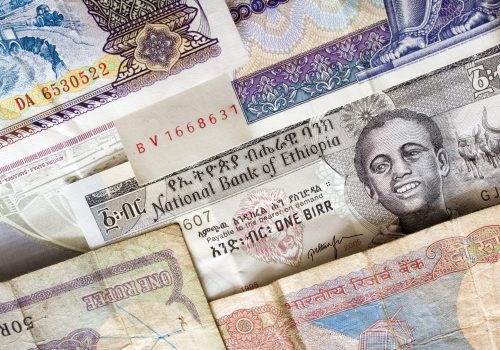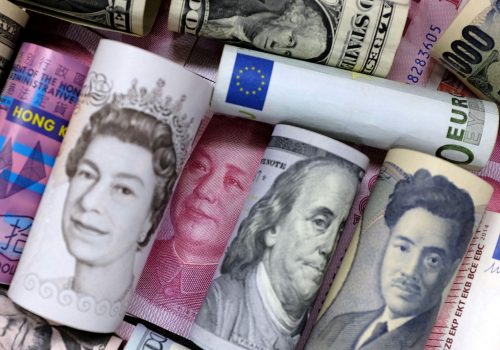Ukraine and Dollar Weaponization
The invasion of Ukraine by Russian forces appears increasingly likely. Over one hundred thousand Russian troops are massed at the border of neighboring Ukraine, there are allegations of cyber attacks and false flag operations, and reports Russia is withdrawing diplomatic staff. America has responded by threatening Russia with an unconventional weapon: the dollar. However, deploying the dollar may actually undermine its power, and hasten its departure from the US arsenal.
In a bid to dissuade the Kremlin from invading, Senate Foreign Relations Committee Chairman Bob Menendez (D-NJ) and 39 other Senators introduced the Defending Ukraine Sovereignty Act (DUSA) on January 18th. The Act seeks to weaponize the global dollar financial system against Russia should it invade Ukraine. The bill threatens to cut Russia off from access to US dollars as a consequence of aggression, including major Russian banks and energy companies.
Most of the bill is standard text designed to invoke authorities created by the 1977 International Emergency Economic Powers Act (IEEPA), but the details are still instructive as a way to understand the power of dollar sovereignty. For instance, Section 310 of DUSA provides for “property blocking”, or the prohibition of facilitating transactions by Russian citizens or entities. Any “US person” — defined as a legal entity with standing in the United States, and including a wide range of global financial institutions — would be prohibited from facilitating financial transactions for sanctioned entities or people. The entire global financial system would face a choice: settle Russian transactions or access US financial markets and infrastructure.
The implications for Russia are dire. From basic payments and management of debt, to cross-border payments and securities transactions, moving money from one financial account to another is a quotidian requirement of global commerce. Russia has international reserves equal to about 35% of GDP, about 21% of which are gold. But with aggressive use of sanctions power, actually spending those reserves to support the ruble and maintain Russian standards of living becomes challenging.
Faced with losing access to financial services involving dollars and cut off from dollars it currently controls, Russia’s central bank would be unable to meet domestic demand for foreign currency. Importers would fail to pay their suppliers. Exporters would receive no new revenues. Meeting normal levels of demand for basic staples would become impossible.
The United States’ ability to hobble Russia to this extent, without firing a shot, highlights the sovereignty of the United States and the dollar in the global economy. In this case, sovereignty is the degree to which a currency issuer can dictate the use of that currency.
The strength of US sovereignty in the global economy first developed as fixed exchange rates based on the post-World War 2 gold standard deteriorated in the 1960s. They were gradually replaced by a global system reliant on dollars as the primary means of cross-border payments and reserves. While other currencies appreciate and depreciate versus the dollar, greenbacks are the best way to move value from one country to another. Dollar denominated assets support the global network of reserves countries use to manage their own currencies and facilitate cross-border financial transactions by banks and other financial institutions.
The current regime of dollar dominance (like pound sterling dominance before it) has a powerful set of network effects preserving it. To start with, the dollar is accepted everywhere because the dollar is accepted everywhere; its convertibility is absolute by virtue of its acceptance. If you need to exchange something from one place or currency or store of value to another, it’s almost always easier to do that by going through dollars because virtually everyone is willing to do business in dollars. Backing up this “natural” network effect is an infrastructure network effect: financial institutions around the world are set up for dollars, not pesos or rand or zloty.
Further reinforcing the network effects of the dollar is its use as a safe asset. 60% of global reserves are denominated in USD. The American financial system and large central government deficits make holding US debt safe, easy, and convenient. Despite being a similar-sized economic bloc, euro-denominated reserves held by central banks are 60% smaller than dollar-denominated reserves. Until another source of safe assets that are liquid (easy to buy and sell), non-volatile (carry stable interest rates), and issued in large quantities (in the trillions of dollars) can be found, the dollar is the best choice for reserve managers.
For the time being, no other government is willing or able to do what is necessary to become a reserve currency. The US is uniquely willing to both borrow in large sums through central government deficits, and run current account deficits that allow those assets to flow to the rest of the world. Historically, the Eurozone has been hobbled by austerity obsession and an unwillingness to issue collective debt. The bloc’s COVID response has helped at the margin with larger deficits and issuance of large-scale collective Eurozone debt, but that change is so far nascent. China’s booming debt markets are dubious from a safety perspective and further hobbled by Chinese management of the capital account which limits the convertibility of the yuan offshore.
Additionally, though multilateral institutions like the World Bank or International Monetary Fund (IMF) do not always explicitly favor the dollar — the IMF’s Special Drawing Rights (SDRs) is composed of a five currency basket — American perspectives still dominate thanks to historical path dependence and inertia. These institutions also lack their own sovereignty to enforce or encourage a shift away from the dollar as the lynchpin of global commerce and reserves.
Finally, the combination of near-universal dollar convertibility, liquidity in dollar reserve assets, and financial system infrastructure designed for dollars, transacting in dollars is much cheaper than other reserve assets. Treasuries trade at tight bid-ask spreads, currency pairs involving the dollar are generally more liquid than non-dollar pairs, and huge volumes of dollar payments create economies of scale for transacting in dollars that other currencies can’t match.
Given the power of dollar sovereignty, it feels inevitable that it would be turned into a weapon in a world that is deeply financialized. Global debt – or, equally accurate, global interest bearing assets – topped $300 trillion in 2021 according to the Institute for International Finance. In that context, the ability to restrict access to financial markets is vastly more powerful than it has been historically.
There are restraints on the use of weaponized dollar sovereignty against Russia. A maximalist weaponization of the dollar would have a large enough impact on the Russian or other adversary’s economy that standards of living would plummet. While not as overt as a bombing campaign, the effects of a fully weaponized dollar would be severe enough that a bombing campaign would be an apt comparison for the impact on the civilian population. It’s not clear to what degree American policymakers are willing to impose pain on Russia’s civilian population, but it seems unlikely the most aggressive possible use of dollar weaponization and the cost to ordinary Russians it would impose would not create negative feedbacks to the United States.
Another obvious restraint is domestic American interest groups. US companies may be users of Russian natural gas, aluminum, or other exports either in the United States or at overseas production facilities. These interests could dissuade US policymakers from using the dollar as a weapon.
The weaponized dollar is already a fact of life in global affairs. The governments of Cuba, Iran, North Korea, and Venezuela can all attest to that fact, as can their civilian populations. In all four countries, dollar sovereignty has been weaponized in a contemporary context. Deeper historical examples abound in Latin America and other parts of the world. At a smaller scale, the wide range of sanctions activity tracked by the Atlantic Council’s Sanctions Dashboard are forms of dollar weaponization as well.
It’s only a matter of time before the United States attempts a more aggressive and maximalist use of financial warfare. Whether Russia will be the target after an invasion of Ukraine remains to be seen. However, at least 40 Senators have signaled they favor that course, and the precedent for similar actions from the United States is well established. On January 19th, President Biden said “If they invade, they’re going to pay. Their banks will not be able to deal in dollars”, a reference either to just one of the wide range of dollar weaponization strategies that exist under current law and are being discussed in Congress.
While there is no current contender to replace the dollar as the dominant currency in global trade and finance, the weaponization of dollar sovereignty could catalyze a push for a new currency hegemony, or perhaps even a multi-currency global reserve system. Game theorists would call aggressive dollar weaponization for narrow national objectives a “non-credible” threat: a threat to do something a rational actor wouldn’t do, because ultimately it hurts the actor. By using the power of dollar sovereignty, dollar sovereignty risks endangering the reserve status which allows it to be weaponized.
Over the foreseeable future of the next decade or so, dollar weaponization will not endanger the US dollar’s unique position as the global reserve currency. The various network effects outlined previously make a near-term shift away from the dollar extraordinarily unlikely. Unfortunately for US policymakers, the long-term is less certain. No economist in 1914 would predict the collapse of the British pound as the global reserve currency, but within a decade the pound was already losing that status to the dollar. Dollar weaponization cannot end the reserve status of the dollar overnight, but it could help to accelerate such a shift. While deploying the dollar as a weapon offers much lower costs than using armed conflict to meet the same ends it is not without costs.
Aggressive use of dollar weaponization has been signaled repeatedly by US policymakers to meet US goals in the current dispute over Ukraine. Though this would severely impact Russia today, negative feedback to dollar sovereignty will be measured in decades rather than years — and will inevitably arrive.
George Pearkes is a contributor for the Atlantic Council’s GeoEconomics Center. He is the Global Macro Strategist for Bespoke Investment Group where he covers markets and economies around the world and across assets.

At the intersection of economics, finance, and foreign policy, the GeoEconomics Center is a translation hub with the goal of helping shape a better global economic future.

